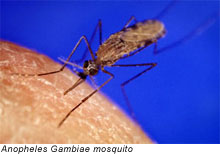|
The mosquito is an insect with a pair of scaled wings,
a slender body, and long legs. The females of most mosquito species
suck blood from other animals. Their overall Size varies, but is
rarely greater than 15 mm (0.6 inch). Mosquitoes weigh only about
2 to 2.5 mg, and can fly at about 1.5 to 2.5 km/h (0.9 to 1.6 mph),
with most species being nocturnal.
|
|

 Don't Scratch: Mosquitos are principally nectar feeders with only the females requiring
a meal of blood. The female mosquito (in almost all species) sucks
the blood of mammals, including humans. Mosquito bites often swell
up hours after happening, causing a red ringed white bump about
a centimeter in diameter. This bump can itch for days and over-scratching
the bite can cause it to bleed. Mosquito bites can transmit diseases,
such as malaria and West Nile Virus, so authorities in many areas
take measures to reduce mosquito populations through pesticides
or more organic means. An easy way to reduce mosquito populations
in a residential area is the removal of standing water (where mosquitoes
breed), and the use of repellents, such as DEET. Don't Scratch: Mosquitos are principally nectar feeders with only the females requiring
a meal of blood. The female mosquito (in almost all species) sucks
the blood of mammals, including humans. Mosquito bites often swell
up hours after happening, causing a red ringed white bump about
a centimeter in diameter. This bump can itch for days and over-scratching
the bite can cause it to bleed. Mosquito bites can transmit diseases,
such as malaria and West Nile Virus, so authorities in many areas
take measures to reduce mosquito populations through pesticides
or more organic means. An easy way to reduce mosquito populations
in a residential area is the removal of standing water (where mosquitoes
breed), and the use of repellents, such as DEET.
 Smells Good: The females of blood sucking species locate their victims primarily
through scent. They are extremely sensitive to the carbon dioxide
in exhaled breath, as well as several substances found in sweat.
Some people seem to attract mosquitoes more than others, with certain
factors making individuals a more likely candidate for a bite: Being
male, being overweight, and having type 'O' blood. Mosquitoes can
detect heat, so they can find warm-blooded mammals and birds very
easily once they get close enough. Smells Good: The females of blood sucking species locate their victims primarily
through scent. They are extremely sensitive to the carbon dioxide
in exhaled breath, as well as several substances found in sweat.
Some people seem to attract mosquitoes more than others, with certain
factors making individuals a more likely candidate for a bite: Being
male, being overweight, and having type 'O' blood. Mosquitoes can
detect heat, so they can find warm-blooded mammals and birds very
easily once they get close enough.
Public Health: In much of the world, mosquitoes are a major public health problem;
they are estimated to transmit disease to more than 700 million
people annually, and will be responsible for the deaths of about
1 in 17 people currently alive. In New Zealand, the UK, Scandinavia,the
United States and other temperate countries, mosquito bites are
mostly just a nuisance.

 Vampire Bite: A mosquito's period of feeding is often undetected; the bite only
becomes apparent because of the immune reaction it provokes. When
a mosquito bites a human, she injects saliva and anti-coagulants.
For any given individual, with the initial bite there is no reaction
but with subsequent bites the body's immune system develops antibodies
and a bite becomes inflamed and itchy within 24 hours. This is the
usual reaction in young children. With more bites, the sensitivity
of the human immune system increases, and an itchy red hive appears
in minutes where the immune response has broken capillary blood
vessels and fluid has collected under the skin. This type of reaction
is common in older children and adults. Some adults can become desensitized
to mosquitoes and have little or no reaction to their bites, while
others can become hyper-sensitive with bites causing large and painful
red welts. Vampire Bite: A mosquito's period of feeding is often undetected; the bite only
becomes apparent because of the immune reaction it provokes. When
a mosquito bites a human, she injects saliva and anti-coagulants.
For any given individual, with the initial bite there is no reaction
but with subsequent bites the body's immune system develops antibodies
and a bite becomes inflamed and itchy within 24 hours. This is the
usual reaction in young children. With more bites, the sensitivity
of the human immune system increases, and an itchy red hive appears
in minutes where the immune response has broken capillary blood
vessels and fluid has collected under the skin. This type of reaction
is common in older children and adults. Some adults can become desensitized
to mosquitoes and have little or no reaction to their bites, while
others can become hyper-sensitive with bites causing large and painful
red welts.
The Circle of Life: The mosquito undergoes complete metamorphosis, going through four
distinct stages in its life cycle: egg, larva, pupa, and adult.
The length of the first three stages is dependent on the species
and temperature. Some species have a life cycle of as little as
four days or up to one month. The larvae are the "wrigglers"
or "wigglers" found in puddles or water-filled containers.
Most larvae feed on microorganisms, but a few are predatory on other
mosquito larvae. Some mosquito larvae, live in unusual situations,
surviving in the water collected inside carnivorous pitcher plants.
All text is available under the terms
of the GNU Free Documentation License
|